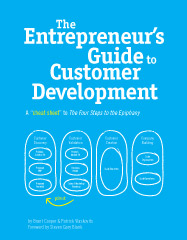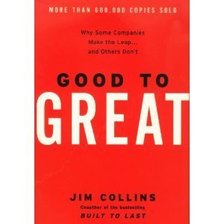 I recently finished reading a book co-authored by my new friend Patrick Vlaskovits. It's called The Entrepreneur's Guide to Customer Development, and it was a fast, enjoyable read. The book's subheading is "A 'cheat sheet' to The Four Steps to the Epiphany," a different book by Steve Blank. As Patrick described to me recently, Steve's book is the bible on customer development practices but is thick and filled with tons of information that is handy as a reference but takes dedication to read from start to finish. Patrick's aim with his book was to distill the main concepts into an easily digestible introduction. I enjoyed reading Patrick's book, and it did fulfill its goal. I'm now motivated more than ever to try to read Steve's book soon. I also was fortunate to recently attend a LeanLA meet-up where I got to meet other members of the community interested in lean start-up concepts (and hear from the founders of Sharethrough how they used lean concepts to build their business). The "Lean" movement, as I've recently learned, is basically combining customer development practices pioneered by Steve Blank with agile development concepts that have been gaining traction in the tech community over the last 5-10 years. The core lessons I took away from the book were as follows. The book is short and sweet, so I won't spoil all the fun (no need to write a distillation of a distillation); go grab a copy yourself. It also has awesome case studies and templates of emails and cold calling example scripts that you probably won't use verbatim but illustrate the concepts really succinctly.
0 Comments
 I recently enjoyed reading Good to Great by Jim Collins. It was as close to a scientific analysis as possible of stock returns of companies versus their mediocre peers and what common threads made those returns possible. Below is a synposis of the main lessons I learned from the book. Collins' team of researchers used extremely selective and careful criteria to pick out companies that performed well ("good") and then outperformed their peers ("great"). The peers they chose for comparison were selected to match industry, size of company, age, etc. so the comparison would be as fair as possible. The book was filled with countless fascinating stories of how the "great" companies achieved their goals and how we as readers can aim to do the same. Disciplined People 1. Level 5 Leadership This term is defined to mean the combination of humility and unwavering resolve/willingness to make tough decisions. The five levels described are as follows: Level 1: Good contributor Level 2: Good team player Level 3: Good team manager Level 4: Inspiring leader Level 5: Humble and ferocious results-seeker It's interesting to compare this to the five levels of tribal leadership/corporate culture from the book Tribal Leadership recently completed and also blogged about. (Maybe everyone just loves the number five for the number of levels in a hierarchy.)  My favorite concept in this chapter was the Window versus the Mirror. Great leaders attribute good results to others and luck (looking outside through a window), and they attribute bad results to themselves (through a mirror). This is the exact opposite of what non-great leaders do. I feel very lucky to really identify with this concept as I find myself able to naturally implement it and find it very frustrating when people I work with attribute poor results outside of themselves. Collins goes on to explain that great leaders considered the role of others as more important than the role of themselves (the humility in the Level 5 Leadership definition). Level 5 leaders also set up their successors for greatness, as the cause they work towards is more important than their personal sense of aggrandizement. The only way level 5 leaders could possibly work is for greatness; they cannot stand mediocrity. I thoroughly agree with this point. Level 5 leaders operate with little to no ego; for them, charisma is unnecessary. The best leaders are often ones we've never heard of. However, Level 5 leaders are present throughout society; it is up to society to make sure they are put in positions of influence to achieve meaningful results. Demonstrative examples in this section included Kimberly Clark's decision to burn its paper mills (beating out Scott), and the Level 5 Leadership at Abbott Labs beating out Upjohn. 2. First who, then what Despite immense pressure to act all the time, the best companies first figured out who they wanted "on the bus" before they figured out where they were going. This was because they could always change direction, but dealing with bad people would be much worse than waiting. When in doubt, don't hire. This was the secret to how Fannie Mae and Wells Fargo performed much better than Bank of America. It is often geniuses who do not think they need a team; it is very common to see companies acting in the model of one genius with 1000 helpers; this is bad because it fails when the genius leaves. Collins also illustrated how compensation turned out to be empirically irrelevant in his study. Who was compensated matters a lot more than the compensation. I look forward to exploring this issue more deeply in my Pay & Rewards class next quarter. The only role, he argued, for compensation was for attraction and retention of the right people, not for motivation. The right people don't need to be managed. In dealing with people, it is important to be rigorous not ruthless. When you know you need to make a change related to people, act fast. You can first try to move people around to different roles before letting them go. Collins pointed out also Packard's Law: revenue growth must match hiring growth of the right people. People alone are not your most important asset; the right people are your most important asset. More specifically, character is more important than skills or knowledge, which can be earned. Disciplined Thought 1. Confront the brutal facts of reality You need to change your company when the environment changes, even if it's tough to do (Kroger could do this, but A&P could not). Don't ignore "scary squiggly" things under rocks you turn over. You have to deal with them even if they are uncomfortable. Less charismatic leaders produce better results because they allow others to debate more. There is no need to motivate; look at facts only, not dreams. Engage in dialogue and debate, not coercion. Lead with questions not answers; have humility to know that you don't know the answers. This rings true for myself and my own philosophies on life. Conduct autopsies without blame, and build "Red Flag Mechanisms" that turn information into information that cannot be ignored. Red Flag Mechanisms are ways your customers and staff can give you information with no penalty and which you cannot ignore. Competing against the best can be invigorating. Use calamities to gain new strength. Collins explained the Stockdale Paradox, which I absolutely loved: Stoically accept the brutal facts of your reality AND have unwavering faith in prevailing in the end. Turn bad experiences into defining moments of your life when you can learn and improve. Never just be an optimist without confronting the brutal facts. Life is unfair; the key is how to deal with it.  2. The Hedgehog Concept A fox is cunning with many strategies but always loses because it is scattered. A hedgehog only knows one thing: how to defend. This is a metaphor for simplifying your world into one simple organizing idea. Reduce all challenges, complexities, and dilemmas into one idea. The intersection of 3 circles is your Hedgehog Concept: Circle 1: What you can be best in world at and what you cannot be best in world at (your genetic encoding) Circle 2: What best drives your economic engine (where you make your money) Circle 3: What you're deeply passionate about The Hedgehog Concept is not a goal but a deep understanding of yourself. The single economic denominator: Profit per what x has the biggest effect on your economic engine? Find that x. Thinking about these cirlces stimulates deep discussion if you must choose just one answer. You cannot just come up with your Hedgehog Concept in a retreat; you must grope through the fog and years of search. Collins then went on to recommend how a council or sort of ninja committee can help to find this concept over time. The cycle that a council should follow is as so: Questions, Debate, Executive Decisions, Autopsy, Repeat -- all guided by the 3 circles. The characteristics of a strong council were as follows:
There are two types of Hedgehog Concepts: content and process. Content Hedgehog: the content of your business is what you care about. Process Hedgehog: the core process that is your one big thing applied to multiple areas. Disciplined Action 1. A culture of discipline Never change objectives or measures after the fact; have the discipline to measure at the end of a year what you set out to do at the beginning, no matter what. This was a bit hard to swallow, but I've worked in teams that didn't adhere to this, and I felt frustrated. You can have freedom in your work but must still be responsible to perform within some framework. The key to success in this is self-disciplined people; manage the system, not the people. No tyrannical disciplinarian is necessary. Adhere to your Hedgehog Concept religiously. Create "stop doing" lists in addition to to-do lists to figure out what you should stop doing to minimize resource and time waste. "Rinse your cottage cheese:" Take every step possible to make yourself one small amount better than others. Budgeting is a process that should not decide how much to allocate among different objectives but what should be fully embraced and what should be fully stopped. 2. Technology accelerators Walgreens was the example analyzed of how great companies adopted internet technology while focusing on their Hedgehog Concept. The process was slow, steady, and methodical. Technology is an accelerator of momentum and change, not a creator of it. One must always consider first, "Does a given technology fit with my Hedgehog Concept?" Technology leaders by themselves often fail; using technology just for its own sake rarely does any good. Also, motivation from a fear of being left behind is counterproductive. The overarching lesson was that technology cannot move good companies to greatness or replace any required step in the framework described in the book.  3. The Flywheel and the Doom Loop Greatness comes not from one foul swoop, but from lots of combined small actions (small pushes on a large "Flywheel" that build momentum over time). The press is often very late to recognize the work of a great company, so they think it's a sudden breakthrough. From the outside, it always looks like one big key event pushed a company to greatness, but from the inside, it always is gradual. "Build-up" is the gradual, disciplined accumulation of knowledge, and "breakthrough" is just passing some threshold. The problems of commitment and alignment go away under the right conditions; make changes slowly over time. Failures come from grand programs and big launches. Stopping and starting new things all the time is the "Doom Loop." This also can occur from new successors changing focus dramatically in order to make their new mark. This is almost always a bad idea. No quick breakthrough usually results; you need sustained slow build-up from the Flywheel. Other Doom Loop strategies: -Misguided acquisitions. Big acquisitions should take place after momentum is built on a Hedgehog Concept. Acquisitions should accelerate Flywheel momentum, not create it. You cannot buy your way to greatness. -Successors undoing each other. Good to Great to Built to Last Early leaders of companies follow the Good to Great framework. After completing the Good to Great research, Collins now thinks that his earlier book Built to Last should be a sequel (even though he wrote it first). Both frameworks help each other. Knowing a start-up's core purpose helps it grow well. Profits and cash flow not the point of life or "Core Ideology;" they are just the blood necessary to live. It's neat how that ties into lessons I've learned in my entrepreneurial finance class last quarter. It doesn't matter what values you have; it just matters that you have and preserve them. Preserve values AND stimulate progress and change. Built to Last ideas (I look forward to reading that book soon):
|
Archives
June 2024
Categories
All
Subscribe |

 RSS Feed
RSS Feed
